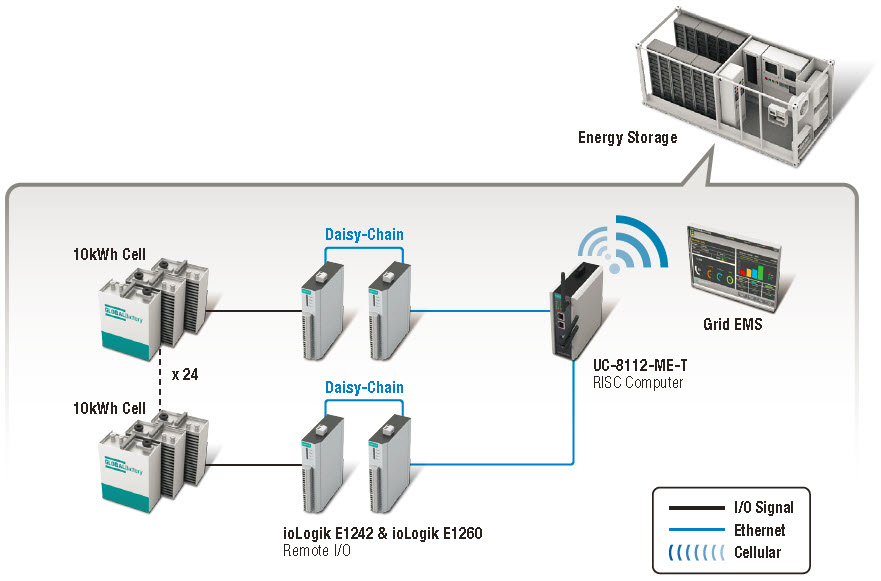Optimizing an Energy Storage System with an IIoT Solution
A recent case study illustrates how a solar power application benefited from using an IIoT setup.
In particular, a system was designed to connect each battery in the system in such a way that engineers
could monitor the temperatures of the batteris, as well as the current generated while the batteries
are being charged and discharged. In this article, we take a closer look at the key solutions that
enabled IIoT connectivity for this application

An energy storage system provider in the US was commissioned to build a 40MWh energy storage system for a key customer in the solar
power industry. It was quickly determined that the customer could benefit from using an IIoT setup, which involves connecting various
components of the energy storage system to the Internet. In particular, a system was designed to connect each battery in the system such a
way that engineers could monitor the temperatures of the batteries, as well as the current generated while the batteries are being charged and
discharged. A detailed analysis of how turning relays on and off at different temperatures affected the amount of power being generated as well
as the life of the abttery allowed the energy storage system provider to optimizte the alogrithms used to control the carhing and discharging of
the batteries. in particular, the algorithm was tweaked so that realys were switches on and off (i.e., the batteries were connected and
disconnected) at the optimal times based on the batteries temperatures.
System Requirements
Solution
The ioLogik E1242-T and ioLogik E1260-T remoteI/O devices with built-in Ethernet switch, and the UC-8112-ME-T wireless-enabled DIN-rail
industrial computer were the best fit for this project. The ioLogik E1242-T´s two DI channels were configured to monitor relay positions, and its
two DO channels were configured to trun relays on and off. Each of the ioLogik E1242-T´s four AI channels were configured to monitor the
current produced by a string of six batteries, and the ioLogik E1260-T´s six RTD channels were configured to monitor the temperatures of the six
batteries. As an added plus, the compact, daisy-chain design of the ioLogik E1242-T and ioLogik E1260-T I/O devices, each of which has a
built-in 2-port Ethernet switch, allows the ioLogiks to be embedded into the battery system without adding an extra unmanaged switch. In
addition, the UC-8112-ME-T industrial computer was configured to log data from the ioLogik E1242-T and ioLogik E1260-T. The system provider
can retrieve the data from the UC-8112-ME-T aat any time andd then use the data as an aid in determining the best charging/discharging
methods. All three products have a wide operating temperature design, which provides an added benefit since the system provider can use a
cost-effective airflow cooling system instead of an expensive HVAC system..

power industry. It was quickly determined that the customer could benefit from using an IIoT setup, which involves connecting various
components of the energy storage system to the Internet. In particular, a system was designed to connect each battery in the system such a
way that engineers could monitor the temperatures of the batteries, as well as the current generated while the batteries are being charged and
discharged. A detailed analysis of how turning relays on and off at different temperatures affected the amount of power being generated as well
as the life of the abttery allowed the energy storage system provider to optimizte the alogrithms used to control the carhing and discharging of
the batteries. in particular, the algorithm was tweaked so that realys were switches on and off (i.e., the batteries were connected and
disconnected) at the optimal times based on the batteries temperatures.
System Requirements
- Monitor and control the charging and discharging of batteries in the system
- Data acquisition for improving the algorithm used to determine the best time to charge and discharge the abtteries and for data analysis
- Suitable for high-temperature operating environments that rely on airflow cooling
Solution
The ioLogik E1242-T and ioLogik E1260-T remoteI/O devices with built-in Ethernet switch, and the UC-8112-ME-T wireless-enabled DIN-rail
industrial computer were the best fit for this project. The ioLogik E1242-T´s two DI channels were configured to monitor relay positions, and its
two DO channels were configured to trun relays on and off. Each of the ioLogik E1242-T´s four AI channels were configured to monitor the
current produced by a string of six batteries, and the ioLogik E1260-T´s six RTD channels were configured to monitor the temperatures of the six
batteries. As an added plus, the compact, daisy-chain design of the ioLogik E1242-T and ioLogik E1260-T I/O devices, each of which has a
built-in 2-port Ethernet switch, allows the ioLogiks to be embedded into the battery system without adding an extra unmanaged switch. In
addition, the UC-8112-ME-T industrial computer was configured to log data from the ioLogik E1242-T and ioLogik E1260-T. The system provider
can retrieve the data from the UC-8112-ME-T aat any time andd then use the data as an aid in determining the best charging/discharging
methods. All three products have a wide operating temperature design, which provides an added benefit since the system provider can use a
cost-effective airflow cooling system instead of an expensive HVAC system..













